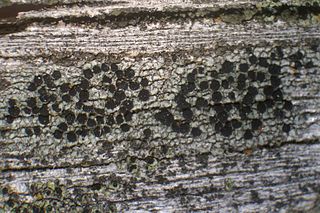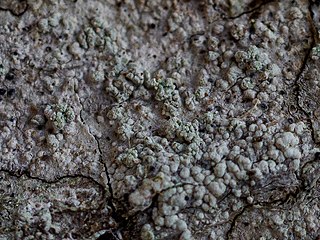
Buellia is a genus of mostly lichen-forming fungi in the family Caliciaceae. The fungi are usually part of a crustose lichen. In this case, the lichen species is given the same name as the fungus. But members may also grow as parasites on lichens (lichenicolous). The algae in the lichen is always a member of the genus Trebouxia.

Immersaria is a genus of lichen-forming fungi in the family Lecideaceae. It has eight species of crustose lichens.
Lecidea lygommella is a species of saxicolous (rock-dwelling), crustose lichen in the family Lecideaceae. It spreads up to 7 cm wide with a thin thallus varying in colour from whitish and pale grey to rusty red-brown, featuring areolate surfaces with irregularly shaped areoles. Its fruiting bodies range from slightly embedded to sitting atop the thallus and black, flat to slightly convex apothecial discs. Unlike its lookalike Lecidea lygomma, L. lygommella does not produce any secondary chemicals. It is found in New South Wales and Victoria, Australia, where it grows on rocks in alpine areas.
Allographa anguilliradians is a species of corticolous (bark-dwelling), crustose lichen in the family Graphidaceae. It has been found in Trinidad and Tobago and Central-West Brazil. Its thallus covers an area of 3 to 7 cm in diameter with a slim profile and a variable surface texture, with a distinct metallic pale grey-olive colour without a prothallus. Its reproductive structures, known as lirellae, form a star-like pattern with black, carbonised outer layers and clear, colourless hymenium, while its ascospores are oblong and segmented, reacting violet-blue to iodine-based stains.
Placolecis kunmingensis is a species of saxicolous (rock-dwelling), crustose lichen in the family Catillariaceae. It is found in Yunnan, China. The lichen is characterised by a thallus that is areolate to squamulose in its centre, forming irregular patches or clumps 10–50 mm wide, as well as its ellipsoid or spherical ascospores with slightly thickened wall.
Tetramelas flindersianus is a saxicolous (rock-dwelling) crustose lichen species in the family Physciaceae. First described scientifically in 2020, it is found in Australia.
Tetramelas gariwerdensis is a species of saxicolous (rock-dwelling), crustose lichen in the family Physciaceae, described in 2020. It is found in the Grampian Mountains in western Victoria, Australia.
Buellia arida is a species of saxicolous (rock-dwelling), crustose lichen in the family Caliciaceae. It occurs in Australia. Buellia arida grows up to 4 cm wide, either concealed within or visible on rock surfaces, forming small, fragmented patches. It features an off-white, dull thallus, numerous black apothecia that become convex over time, and spores that evolve from pale to dark brown, characterized by their ellipsoid shape and finely decorated surface.
Buellia cravenii is a species of saxicolous (rock-dwelling), crustose lichen in the family Caliciaceae. It is found in Australia. The lichen spreads up to 3.5 cm wide thick, forming a continuous, grey-white cracked pattern of areoles.
Buellia eldridgei is a rare species of terricolous (ground-dwelling), crustose lichen in the family Caliciaceae, known to occur only in Queensland, Australia.
Buellia kowenensis is a rare species of saxicolous (rock-dwelling), crustose lichen in the family Caliciaceae. It is only known to occur at its original collection site in the Australian Capital Territory of Australia.
Buellia lordhowensis is a little-known saxicolous (rock-dwelling), crustose lichen species in the family Caliciaceae, first described in 2020. It is only known to occur on Lord Howe Island, Australia.
Buellia phillipensis is a little-known species of saxicolous (rock-dwelling), crustose lichen in the family Caliciaceae, described in 2020. It is only known to occur on Phillip Island in the Southwest Pacific.
Baculifera confusa is a species of lignicolous (wood-dwelling), crustose lichen in the family Caliciaceae. It is found in Australia.
Elixjohnia jackelixii is a species of saxicolous (rock-dwelling), crustose lichen in the family Teloschistaceae. It is found in Australia and New Zealand. The lichen is characterised by its unique multilayered appearance with outer sterile rings that are brownish or greenish-yellow and inner areoles that are whitish, yellowish, or greyish, often cracked to reveal the medulla underneath. Its fruiting bodies, or apothecia, are typically attached directly to the thallus and vary in colour and shape.
Caloplaca lecanorocarpa is a species of saxicolous (rock-dwelling), crustose lichen in the family Teloschistaceae. Found in Brazil, it was formally described as a new species in 2016 by the lichenologists André Aptroot and Marcela Cáceres. It is named for its overall appearance to lichens in the Lecanora subfusca species complex.
Caloplaca lecapustulata is a species of saxicolous (rock-dwelling), crustose lichen in the family Teloschistaceae. Found in Brazil, it was described as a new species in 2016.

Buellia oidalea is a species of crustose lichen found along the Pacific coast of North America, from Coos County, Oregon to Baja California Sur.

Buellia griseovirens is a species of lichen belonging to the family Caliciaceae. It exhibits a crustose growth type and is commonly found on well-lit, smooth bark, and worked timber surfaces. The species can tolerate moderate pollution.
Buellia bahiana is a crustose-type lichen species that frequently grows on the bark and wood of trees found in coastal and inland forest habitats. This lichen species exhibits a broad geographic distribution, being documented in various pantropical and subtropical regions around the world. Specific areas where Buellia bahiana has been recorded include parts of Australia, Africa, North America, Central America, South America, and several Pacific Island chains.



